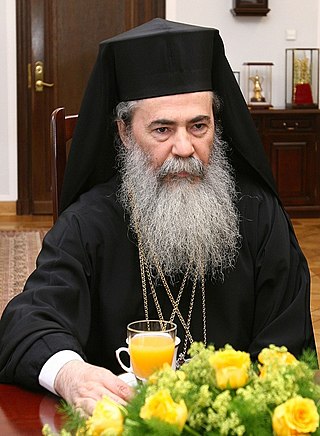Related Research Articles

The Greek Orthodox patriarch of Jerusalem or Eastern Orthodox patriarch of Jerusalem, officially patriarch of Jerusalem, is the head bishop of the Greek Orthodox Patriarchate of Jerusalem, ranking fourth of nine patriarchs in the Eastern Orthodox Church. Since 2005, the Eastern Orthodox patriarch of Jerusalem has been Theophilos III. The patriarch is styled "Patriarch of the Holy City of Jerusalem and all Holy Land, Syria, beyond the Jordan River, Cana of Galilee, and Holy Zion." The patriarch is the head of the Brotherhood of the Holy Sepulchre, and the religious leader of about 130,000 Eastern Orthodox Christians in the Holy Land, most of them Palestinian Christians in Israel and Palestine.

This is a timeline of major events in the history of Jerusalem; a city that had been fought over sixteen times in its history. During its long history, Jerusalem has been destroyed twice, besieged 23 times, attacked 52 times, and captured and recaptured 44 times.

The Greek Orthodox Patriarchate of Jerusalem, also known as the Greek Orthodox Church of Jerusalem, is an autocephalous church within the wider communion of Eastern Orthodox Christianity. Established in the mid-fifth century as one of the oldest patriarchates in Christendom, it is headquartered in the Church of the Holy Sepulchre in Jerusalem and led by the patriarch of Jerusalem, currently Theophilos III. The patriarchate's ecclesiastical jurisdiction includes roughly 200,000 to 500,000 Orthodox Christians across the Holy Land in Palestine, Jordan and Israel.

Simeon of Jerusalem, or Simon of Clopas, was a Jewish Christian leader and according to most Christian traditions the second Bishop of Jerusalem, succeeding James, brother of Jesus. Simeon is sometimes identified with Simon, brother of Jesus, and has also been identified with the Apostle Simon the Zealot.
The history of the Jews and the Crusades is part of the history of antisemitism toward Jews in the Middle Ages. The call for the First Crusade intensified the persecutions of the Jews, and they continued to be targets of Crusaders' violence and hatred throughout the Crusades.
Michael Solomon Alexander was the first Anglican Bishop in Jerusalem.

Jerusalem's role in first-century Christianity, during the ministry of Jesus and the Apostolic Age, as recorded in the New Testament, gives it great importance, both culturally and religiously, in Christianity. Jerusalem is generally considered the cradle of Christianity.
Matthias of Jerusalem was a 2nd-century Christian saint and a Bishop of Jerusalem, whose episcopacy was about 113–120 AD.
The Church's Ministry Among Jewish People (CMJ) is an Anglican missionary society founded in 1809.

Christ Church, Jerusalem, is an Anglican church located inside the Old City of Jerusalem, established in 1849 by the London Society for Promoting Christianity Amongst the Jews. It was the original seat of the Anglican Bishop in Jerusalem until the opening of St. George's Cathedral, Jerusalem in 1899; the compound also included the 19th century British Consulate. From its inception, Christ Church has been supporting a form of Christianity focused on Jesus' Jewishness, offering Christian texts translated into Hebrew by its own leaders.
Early Christianity, otherwise called the Early Church or Paleo-Christianity, describes the historical era of the Christian religion up to the First Council of Nicaea in 325. Christianity spread from the Levant, across the Roman Empire, and beyond. Originally, this progression was closely connected to already established Jewish centers in the Holy Land and the Jewish diaspora throughout the Eastern Mediterranean. The first followers of Christianity were Jews who had converted to the faith, i.e. Jewish Christians. Early Christianity contains the Apostolic Age and is followed by, and substantially overlaps with, the Patristic era.
Tobias of Jerusalem was the fifth Bishop of Jerusalem, who lived in the 2nd century. He was acquainted with Addai of Edessa, one of the seventy disciples and a miraculous healer.
Benjamin I of Jerusalem was the 2nd-century 6th bishop of Jerusalem. According to Eusebius of Caesarea he was a Jewish Christian. His short episcopacy was only from about 116 to 117 AD. He was possibly killed in the persecution of Hadrian (117–138), His Feast Day was December 11.
John I of Jerusalem was the seventh Bishop of Jerusalem.
Justus II of Jerusalem was a 2nd-century Jewish Christian bishop of Jerusalem.
Levis of Jerusalem was a 2nd-century Jewish Christian bishop of Jerusalem.
Ephram of Jerusalem was a 2nd-century Jewish Christian bishop of Jerusalem.
Joseph I of Jerusalem was a 2nd-century Jewish Christian bishop of Jerusalem.
Senecas of Jerusalem was a 2nd century Jewish Christian bishop of Jerusalem.
This is a list of the bishops of Jerusalem before the Council of Chalcedon (451), which provoked a schism.
References
- ↑ Historia Ecclesiastica , IV, v."
- ↑ Who was a Christian? Archived 2017-03-25 at the Wayback Machine in the Holy Land.